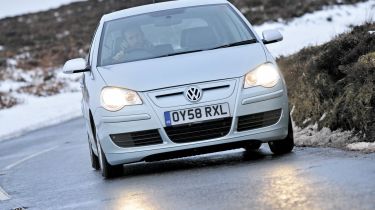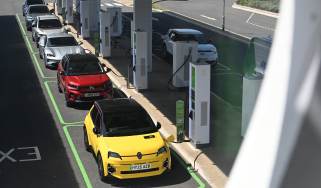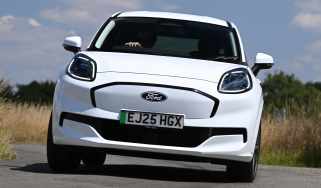German contender has been a trailblazer for eco city cars
Even though it was the most economical supermini in the test, the Polo BlueMotion is expensive – so it only really makes sense if you want to reduce your emissions, rather than save money.
If you want to go further for less, the Polo BlueMotion is the best in the business. Along with its sister model, the previous-generation SEAT Ibiza Ecomotive, the green VW has long set the CO2 standard with emissions of 99g/km.
Compare the German model’s spec sheet to that of the new Fiesta, and it’s as if Ford was determined to better the Polo’s stats. The BlueMotion puts out 99g/km; the ECOnetic emits 98g/km. The VW claims 74.3mpg; the Ford achieves 76.3mpg. This gives the blue oval model the eco edge, but it will only cut 12,000-mile fuel bills by a paltry £19 per year… in theory.
In practice, the difference between the two superminis was turned on its head. The BlueMotion proved to be the cheapest car to cover our trip, requiring only £20.50 of diesel to be poured into its tank at the end of the 300-mile journey. That’s a mere £1.48 less than the Fiesta, but a driver who covered 12,000 miles annually and matched our economy would actually save £59 per year if they choose the VW. So how did the Polo manage to use its diesel so sparingly? Within the first five minutes of driving, the answer is clear – its gearing is the most compromised towards economy of all the cars in this test.
Used - available now

2023 Mercedes
A-Class
10,727 milesAutomaticPetrol1.3L
Cash £21,500
2024 BMW
5 Series Touring
12,031 milesAutomaticDiesel2.0L
Cash £31,500
2020 Land Rover
Range Rover
31,181 milesAutomaticDiesel3.0L
Cash £40,000
2023 Polestar
2
29,604 milesAutomaticElectric
Cash £20,800From behind the wheel, the biggest difference between the BlueMotion and a standard Polo is the awkward ratios of the five-speed manual transmission. Gears are taller than normal, allowing the engine to rev lower at higher speeds, which takes some getting used to. Cruising at 30mph in fourth is a non-starter, while tackling 50mph in fifth has the engine coughing.
At first this is an irritation, but after you’ve covered a few miles you begin to enjoy being reminded that this car was designed for economy. Changing ratios at the perfect time and using the lightest possible throttle becomes a habit rather than a chore as you watch the dash mpg read-out creep towards the magic 70 mark!
However, there’s a price to pay for this. While the Ford feels agile and refined, the BlueMotion falls even further behind than standard versions of the ageing supermini. Eco tyres help to reduce rolling resistance, but do nothing for cornering grip and give poor traction in wet or icy conditions. Push the engine, and while progress is brisk the three-cylinder’s buzz is unavoidable.
The cabin appears dated and is cramped, but at least the Polo still looks stylish. Alloy wheels and a smart aerodynamic bodykit give both three and five-door versions of the German model a visual boost. We’re less impressed by the prices. The entry-level variant is yours for £12,725, yet this more luxurious five-door BlueMotion 2 costs £14,115. This is a fuel gauge watcher’s dream, but justifying that outlay is difficult.
Details
Chart position: 3
WHY: Until the latest Fiesta arrived, the Polo was the official CO2 champion.



